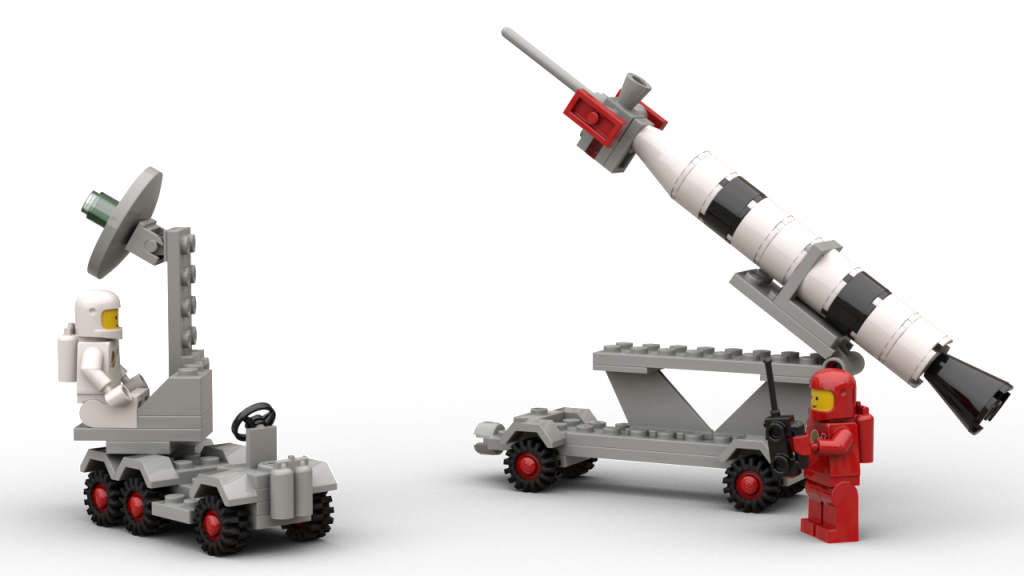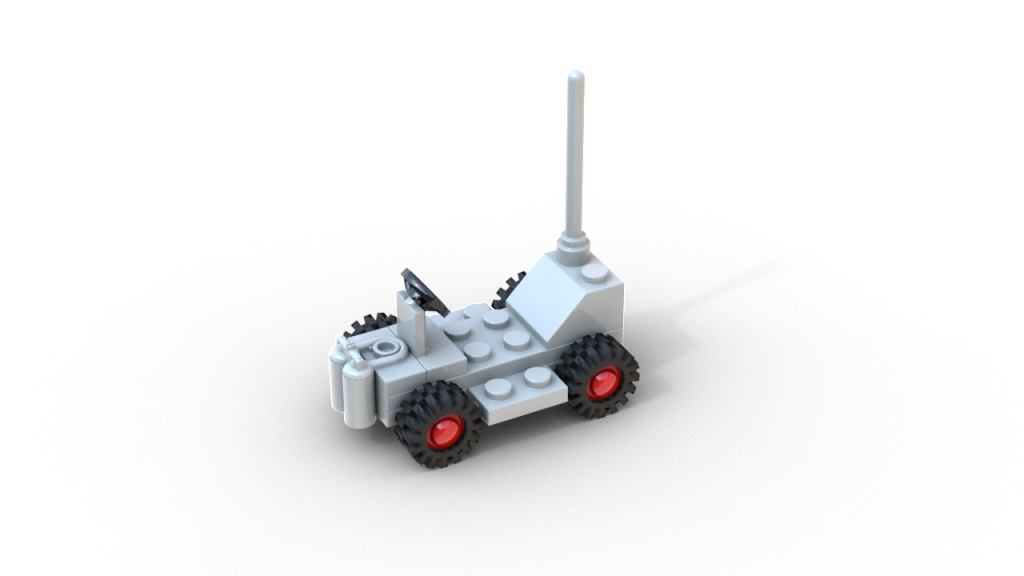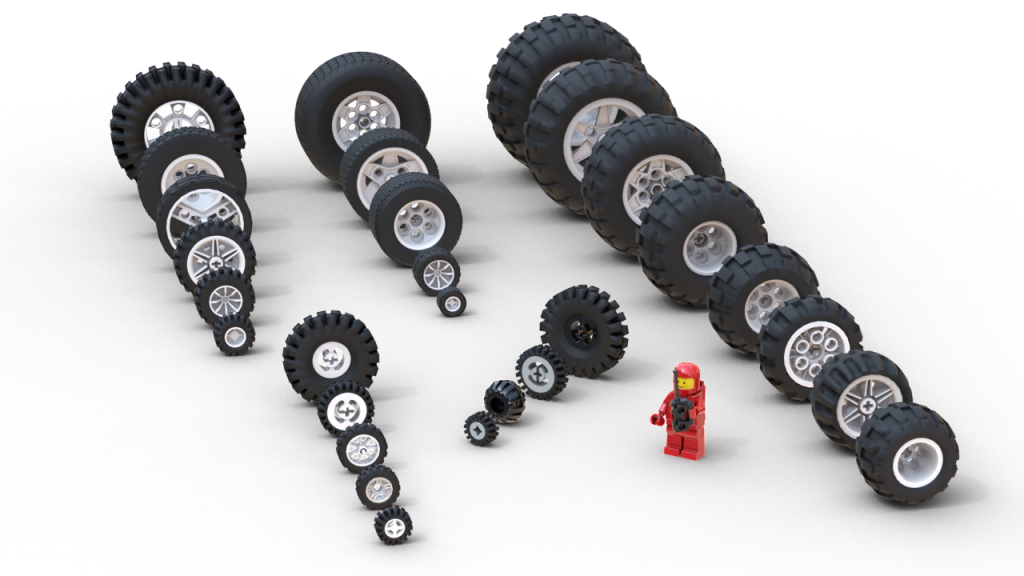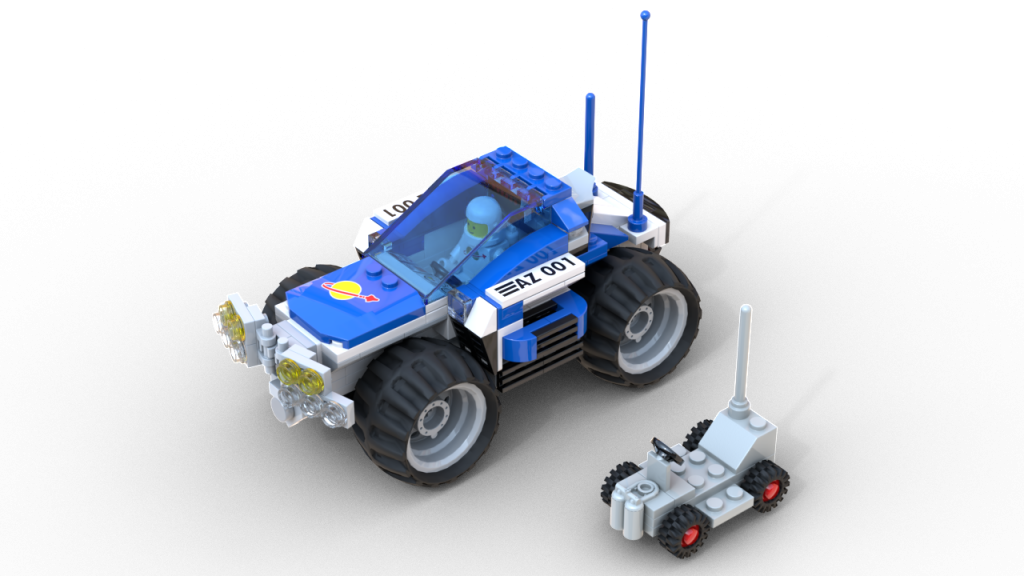It has been a while since I had my collection of LEGO Classic Space Sets “out and assembled”. I am still lacking the space but that is not keeping me from looking back and playing a bit with ideas, the computer, and the actual bricks.
One of the earlier sets of the Classic Space theme is a small Rocket Launcher which hit the market as early as 1978, making it one of the very first sets of the theme. The LEGO Set Number in Europe is 897, the US-Market saw the set as 462.

The original set is made up from 60 individual pieces and includes two Classic Spaceman mini figures.
The set shows many of the signs of the early classic themes – the vehicles are using the small wheels and mudguards. The steering wheel is the only control and the gray oxygen tank supposedly provides some sort of power or energy to the vehicle.
Other than that, the set shows that even a “simple” design can bring fun: the set is a bit fragile in as much as the satellite has a single-stud connection to the top of the rocket, the rocket itself is attached to the trailer with a gray bracket that does not provide a stable connection to the two parts of the rocket, etc. Nonetheless, this one is in fact classic and almost anyone into collection Classic Space sets will have one of these rather inexpensive sets.
An even more basic set is #886, the Space Buggy. You can build the little “car” which became the standard transportation unit for many other sets as well with just 9 bricks (assuming you count the two wheel holders as one brick).

MOCs – “My Own Creation”
Building your very “own” models is the spirit of LEGO since it first appeared on the marked (and certainly since it appears in my room when I was a kid). However, the time of “crude” models of my childhood is gone and that makes creation “your very own Classic Space model” difficult, both in time, construction, and… money. But nowadays, software such as Stud.io can help…
When creating a MOC of any set, the first thoughts go to the style. If you are a purist, you can limit yourself to exactly those bricks available in the theme when it was created at its time. A little “less” purist, you can try to follow the theme’s spirit, e.g. by maintaining the size factor and the coloring scheme.
As for the matter of size – it matters! The original sets were tiny, if you take the spacemen as reference, the vehicles and buildings do not really provide much room or security. But then, when designing a MOC, it cannot be too much larger than the originals, otherwise you will never be able to show both in the same scene…
The parts are another issue: if you have a collection of Classic Space sets, you have plenty of bricks for the MOCs but on the other hand, you don’t have any of the modern parts that make the models so “pretty”.
Let’s take a look at the wheels first – the original set uses the LEGO Parts #3641 and #122c01 to form the wheels. These are topped by a mudguard (#3787). Generally looking at the wheels used in Classic Space, this is what you are going to find:

These appear in a variety of sets, some only in very few Classic Space sets, others in almost any set that has a need for wheels. Now, looking at today’s catalog of parts (for wheels), this is a sample of what you can expect… and I did not bother trying the different styles of rims for each one.

So there is plenty to choose from if you are willing to deviate from the original wheels. Some are matching the original size, some are significantly bigger. What you are going to make from them… is up to you.
As I said: Size matters!
And with that, I mean the size or rather the dimensions of the builds and your MOCs. The original Lunar Buggy (#886) is rather small – in Studs (the number of “knobs”) it measures 7 x 4 x 8 (Width x Length x Height) approximately. Which – in centimeters – is 5.4 x 3.2 x 6.1.
I have created a MOC of a more sophisticated Lunar Rover for a single spaceman – it features a closed cockpit, instruments, engine compartment, sufficient light bars, etc. but it is larger, of course: in Studs, it goes by the dimensions of 18 x 10 x 9 which is approximately a triple size compared to the original.
All in all, I am pretty happy with my MOC – although a bit oversized, I think it captures the original Classic Space spirit of the later years (blue and white) and shows a modern design (at the cost of using parts that are not from the Classic Space time).
The model is assembled from 190 parts and is “mostly build-able” as only very few parts are not available in the color that I have picked them in (and there are close substitute colors available). Although this is “my” design, there has been some inspiration by the guys from #KeepOnBricking, especially the YouTube Video on an Extreme Off Road Buggy.





